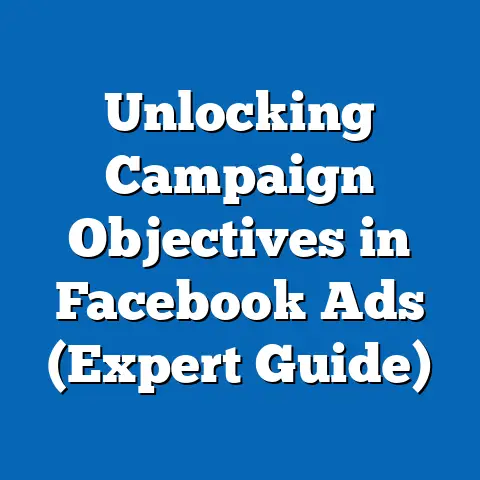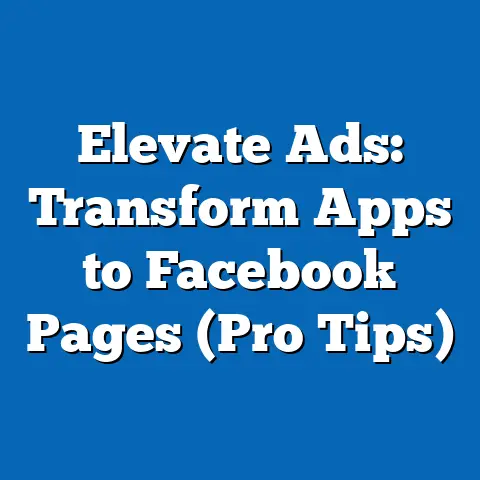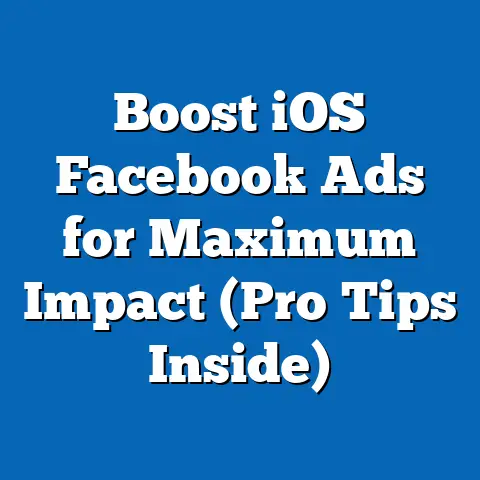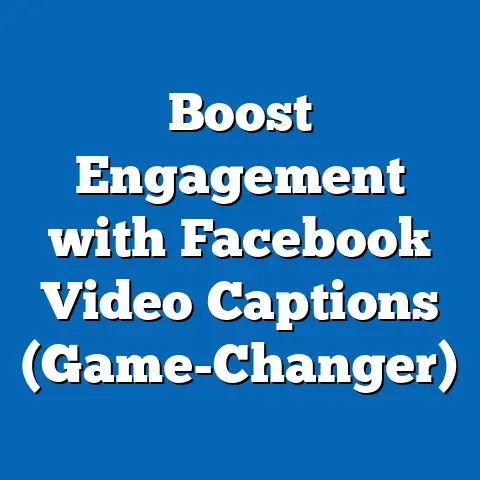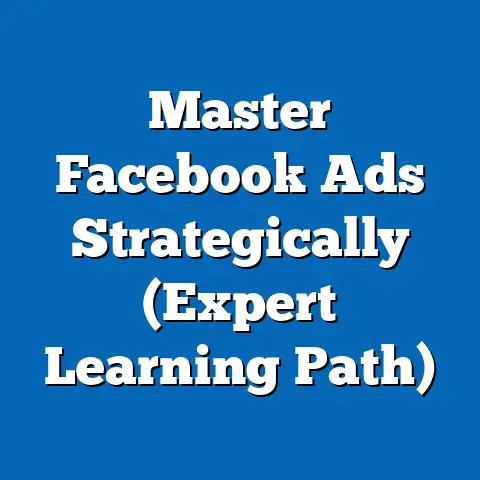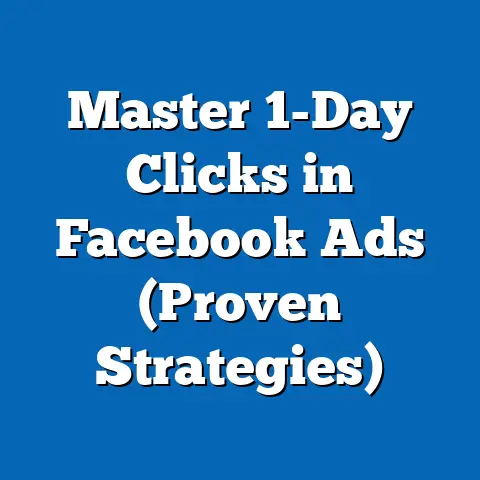Targeting Individuals with Facebook Ads (Expert Insights)
Imagine Maria, a passionate small business owner with a charming local café nestled in a bustling urban neighborhood. She pours her heart into crafting delicious pastries and brewing exceptional coffee, yet her café remains surprisingly quiet during peak hours. The aroma of freshly baked goods and the promise of a perfect latte seem lost in the city’s noise. One day, driven by a desire to connect with her community, Maria decides to harness the power of Facebook ads. As she dives into setting up her first campaign, she begins to envision reaching her ideal customers: young professionals who live nearby, coffee aficionados, and foodies who are always scrolling through social media for their next culinary adventure. This is the power of Facebook advertising – the ability to laser-focus your message on the individuals who are most likely to become your loyal patrons. In this guide, I’ll show you how Maria’s journey reflects the immense potential of targeted advertising on Facebook and how you can replicate her success.
Understanding the Basics of Facebook Ads Targeting
Facebook advertising is more than just throwing money at a platform and hoping for the best. It’s about understanding the intricate web of targeting options available and using them to connect with the right people. The platform offers a variety of targeting methods, each designed to help you reach specific segments of the population with maximum effectiveness.
- Demographic Targeting: This is the foundational layer, allowing you to target users based on attributes like age, gender, location, education, job title, and relationship status. For Maria, this means she can target individuals aged 25-40 living within a 5-mile radius of her café.
- Interest Targeting: Facebook allows you to reach users based on their stated interests, hobbies, and the pages they’ve liked. Maria can target people interested in “coffee,” “pastries,” “local cafes,” or even specific food bloggers.
- Behavior Targeting: This targets users based on their online behavior, such as purchase history, device usage, travel habits, and more. Maria could target users who frequently dine out or use food delivery apps.
- Custom Audiences: This is where things get really powerful. You can upload your own customer lists (email addresses, phone numbers) or use website visitor data (through the Facebook Pixel) to create custom audiences. Maria can target existing customers to encourage repeat visits or retarget website visitors who abandoned their online order.
The Importance of Audience Research
Before you even think about crafting your ad copy or selecting your visuals, you need to dive deep into audience research. Understanding your target audience’s preferences, pain points, and online behaviors is crucial for creating ad campaigns that truly resonate. It’s like knowing your customer’s favorite coffee blend before you even ask for their order – you’re already one step ahead.
I’ve seen countless campaigns fail simply because the advertiser didn’t take the time to understand their audience. They made assumptions, relied on gut feelings, and ultimately wasted their ad spend. Don’t make the same mistake.
Here are some tools and strategies for conducting thorough audience research:
- Facebook Audience Insights: This free tool within Facebook Ads Manager provides valuable insights into your target audience’s demographics, interests, behaviors, and page likes. It’s a goldmine of information.
- Surveys: Direct feedback is invaluable. Use online survey platforms like SurveyMonkey or Google Forms to gather data about your target audience’s preferences, needs, and motivations.
- Social Listening: Monitor social media conversations to understand what your target audience is talking about, the challenges they face, and the brands they admire. Tools like Brandwatch and Mention can help you track relevant keywords and hashtags.
- Competitor Analysis: Analyze your competitors’ Facebook pages and ads to see who they’re targeting and what messaging they’re using. This can provide valuable clues about your own target audience.
For Maria, this meant understanding that her ideal customer wasn’t just anyone who liked coffee. It was the young professional who needed a quick caffeine fix before work, the student who wanted a cozy place to study, and the local resident who appreciated high-quality ingredients and a welcoming atmosphere. By understanding these nuances, she could tailor her ads to speak directly to their needs.
Crafting Compelling Ad Content for Targeted Audiences
Once you have a solid understanding of your target audience, it’s time to craft ad content that grabs their attention and compels them to take action. This is where the creative magic happens.
The key is to tailor your messaging to align with the interests and values of your target audience. Here are some examples of successful ad copy, visuals, and calls-to-action that have effectively captured the attention of specific demographics:
- Example 1: Targeting Young Professionals
- Visual: A high-quality image of a young professional working on a laptop in a bright, modern café setting.
- Ad Copy: “Need a productive workspace with a delicious coffee boost? [Café Name] offers a quiet atmosphere, fast Wi-Fi, and the best lattes in town. Fuel your workday with us!”
- Call-to-Action: “Learn More” (linking to the café’s website with workspace details)
- Example 2: Targeting Students
- Visual: An inviting image of a cozy corner in the café with students studying and enjoying coffee.
- Ad Copy: “Study smarter, not harder! [Café Name] is the perfect spot for your next study session. Enjoy comfortable seating, free Wi-Fi, and a wide selection of snacks and drinks. Show your student ID for a 10% discount!”
- Call-to-Action: “Get Directions” (linking to the café’s Google Maps location)
- Example 3: Targeting Local Residents
- Visual: A warm, inviting image of the café’s exterior with people enjoying the outdoor seating.
- Ad Copy: “Discover your new neighborhood hangout! [Café Name] is a locally owned café serving fresh, high-quality pastries and expertly brewed coffee. Join us for a taste of community.”
- Call-to-Action: “Visit Our Page” (linking to the café’s Facebook page)
- Visual: A high-quality image of a young professional working on a laptop in a bright, modern café setting.
- Ad Copy: “Need a productive workspace with a delicious coffee boost? [Café Name] offers a quiet atmosphere, fast Wi-Fi, and the best lattes in town. Fuel your workday with us!”
- Call-to-Action: “Learn More” (linking to the café’s website with workspace details)
- Visual: An inviting image of a cozy corner in the café with students studying and enjoying coffee.
- Ad Copy: “Study smarter, not harder! [Café Name] is the perfect spot for your next study session. Enjoy comfortable seating, free Wi-Fi, and a wide selection of snacks and drinks. Show your student ID for a 10% discount!”
- Call-to-Action: “Get Directions” (linking to the café’s Google Maps location)
- Visual: A warm, inviting image of the café’s exterior with people enjoying the outdoor seating.
- Ad Copy: “Discover your new neighborhood hangout! [Café Name] is a locally owned café serving fresh, high-quality pastries and expertly brewed coffee. Join us for a taste of community.”
- Call-to-Action: “Visit Our Page” (linking to the café’s Facebook page)
The common thread in these examples is relevance. Each ad speaks directly to the specific needs and desires of the target audience. Remember, your ad is competing for attention in a crowded digital landscape. Make sure it stands out by being relevant, engaging, and visually appealing.
Leveraging Facebook’s Advanced Targeting Features
Facebook’s advanced targeting features are like secret weapons in your advertising arsenal. They allow you to reach individuals who are more likely to convert based on their online behavior and interests. Let’s explore some of these powerful tools:
- Lookalike Audiences: This feature allows you to create audiences that are similar to your existing customers or website visitors. Facebook analyzes the characteristics of your source audience and identifies other users who share those same traits. For Maria, this meant creating a lookalike audience based on her existing customer list, allowing her to reach new potential customers who were likely to enjoy her café.
- Retargeting: This feature allows you to show ads to people who have previously interacted with your website or Facebook page. For example, if someone visited Maria’s website and viewed the menu but didn’t place an order, she could retarget them with an ad offering a special discount to encourage them to try her pastries.
- Dynamic Ads: These ads automatically show the most relevant products or services to individual users based on their browsing history and interests. If someone viewed a specific type of coffee on Maria’s website, they could be shown a dynamic ad featuring that coffee and other similar products.
I’ve personally seen these advanced targeting features significantly boost campaign performance. In one case, by using lookalike audiences, I was able to increase conversion rates by 30% and reduce cost per acquisition by 20%. The key is to experiment and find the strategies that work best for your specific business and target audience.
Measuring Success and Optimizing Ad Campaigns
Creating a targeted Facebook ad campaign is just the beginning. The real magic happens when you start measuring your results and optimizing your campaigns for better performance.
Here are some key metrics and KPIs (Key Performance Indicators) that you should be tracking:
- Reach: The number of unique people who saw your ad.
- Impressions: The number of times your ad was displayed.
- Click-Through Rate (CTR): The percentage of people who saw your ad and clicked on it.
- Conversion Rate: The percentage of people who completed a desired action (e.g., made a purchase, filled out a form) after clicking on your ad.
- Cost Per Acquisition (CPA): The cost of acquiring one customer through your ad campaign.
- Return on Ad Spend (ROAS): The amount of revenue generated for every dollar spent on advertising.
A/B testing is your best friend when it comes to optimizing your campaigns. Test different ad copy, visuals, calls-to-action, and targeting options to see what resonates best with your audience. For Maria, this meant testing different images of her pastries, different headlines, and different calls-to-action to see which combination drove the most visits to her café.
Remember, data is your guide. Pay attention to the numbers, analyze your results, and make adjustments accordingly. Don’t be afraid to experiment and try new things. The Facebook advertising landscape is constantly evolving, so you need to be agile and adaptable to stay ahead of the curve.
Conclusion
Targeted Facebook advertising has the transformative potential to elevate businesses, just like it did for Maria’s café. By mastering the art of audience targeting, you can drive sales, increase brand awareness, and foster customer loyalty.
Imagine your own success story. Envision the impact of connecting with your ideal customers, driving traffic to your website, and generating leads for your business. The power of precise targeting on Facebook is within your reach. Take the next step in your advertising journey and unlock the full potential of this powerful platform.

